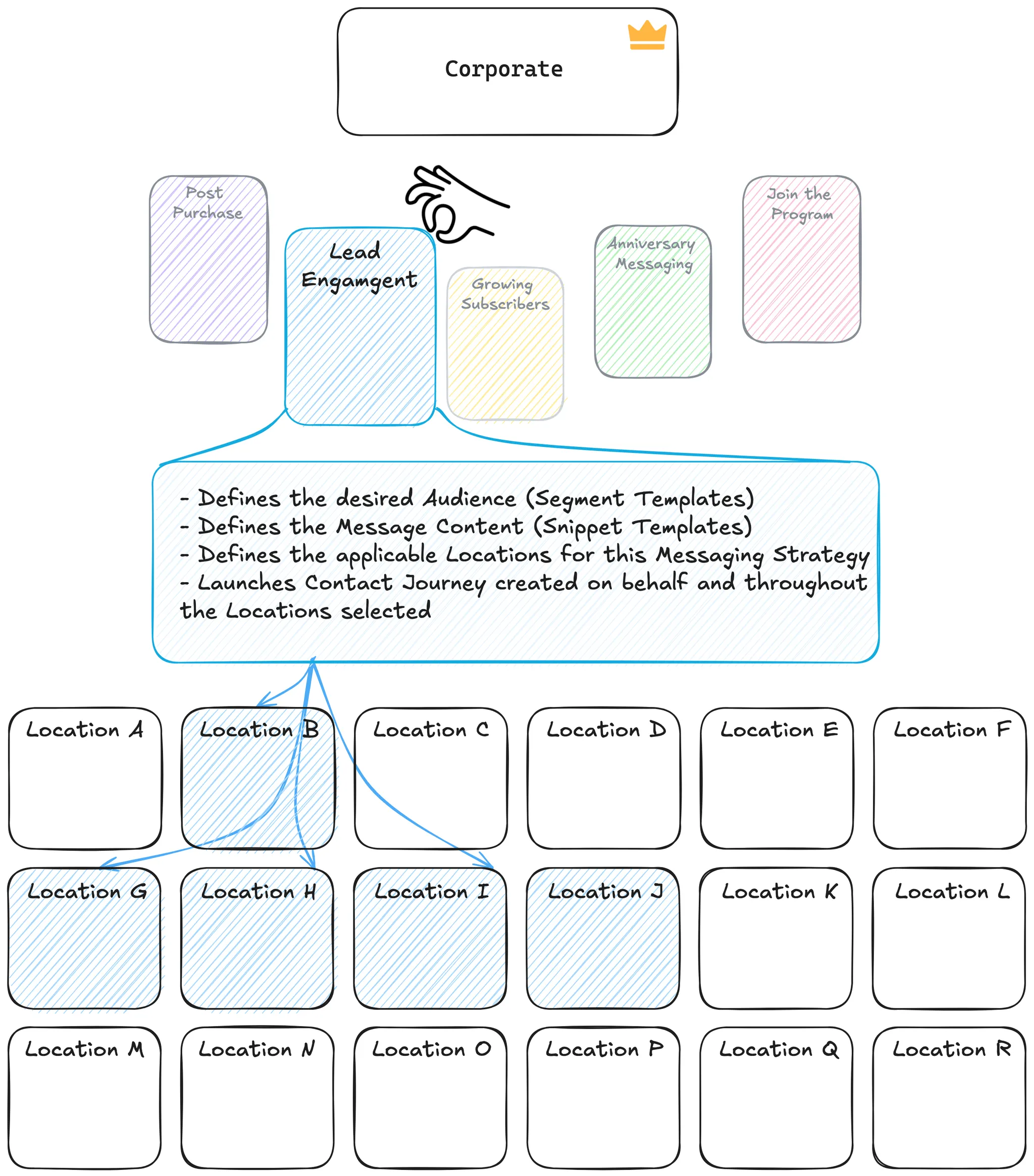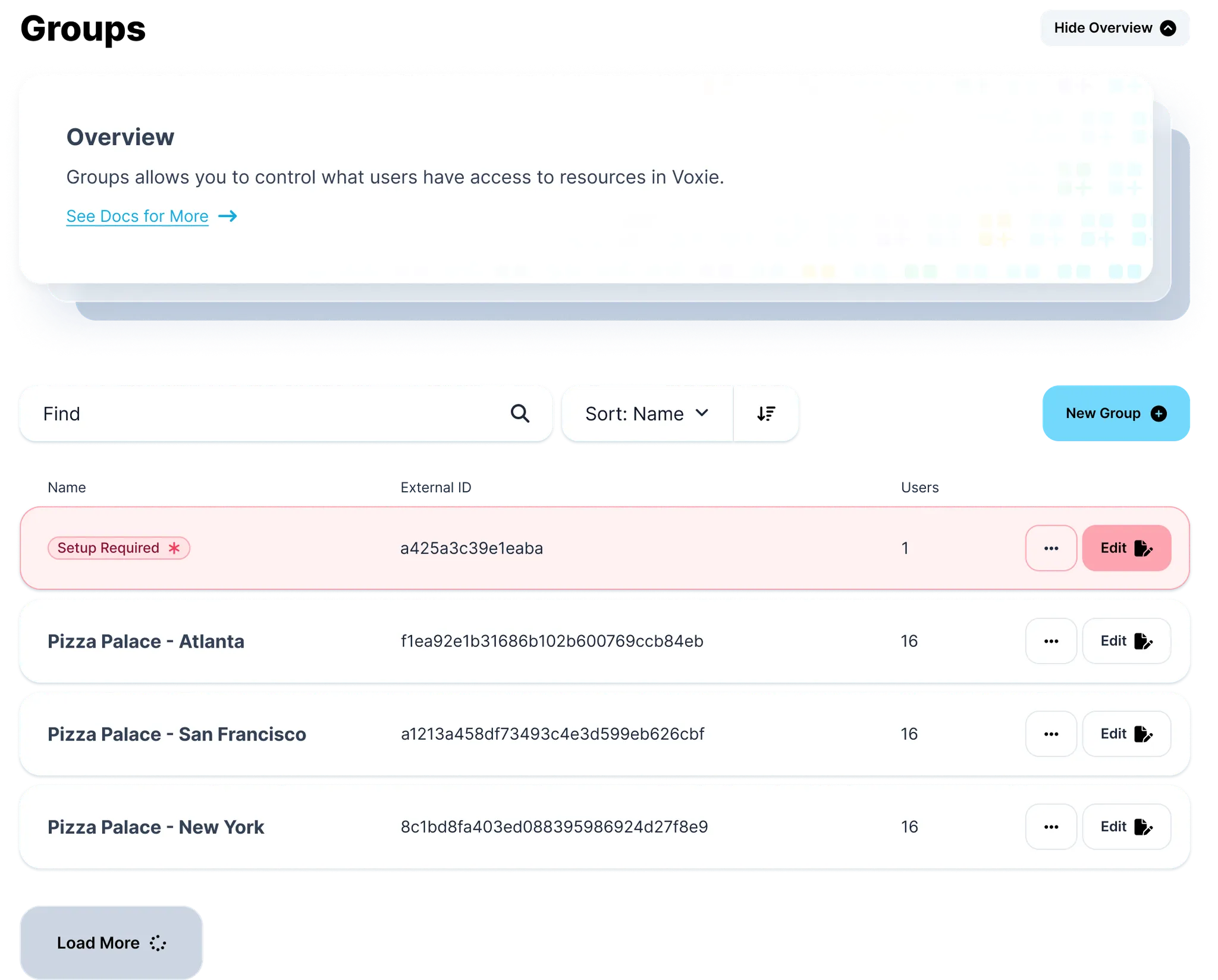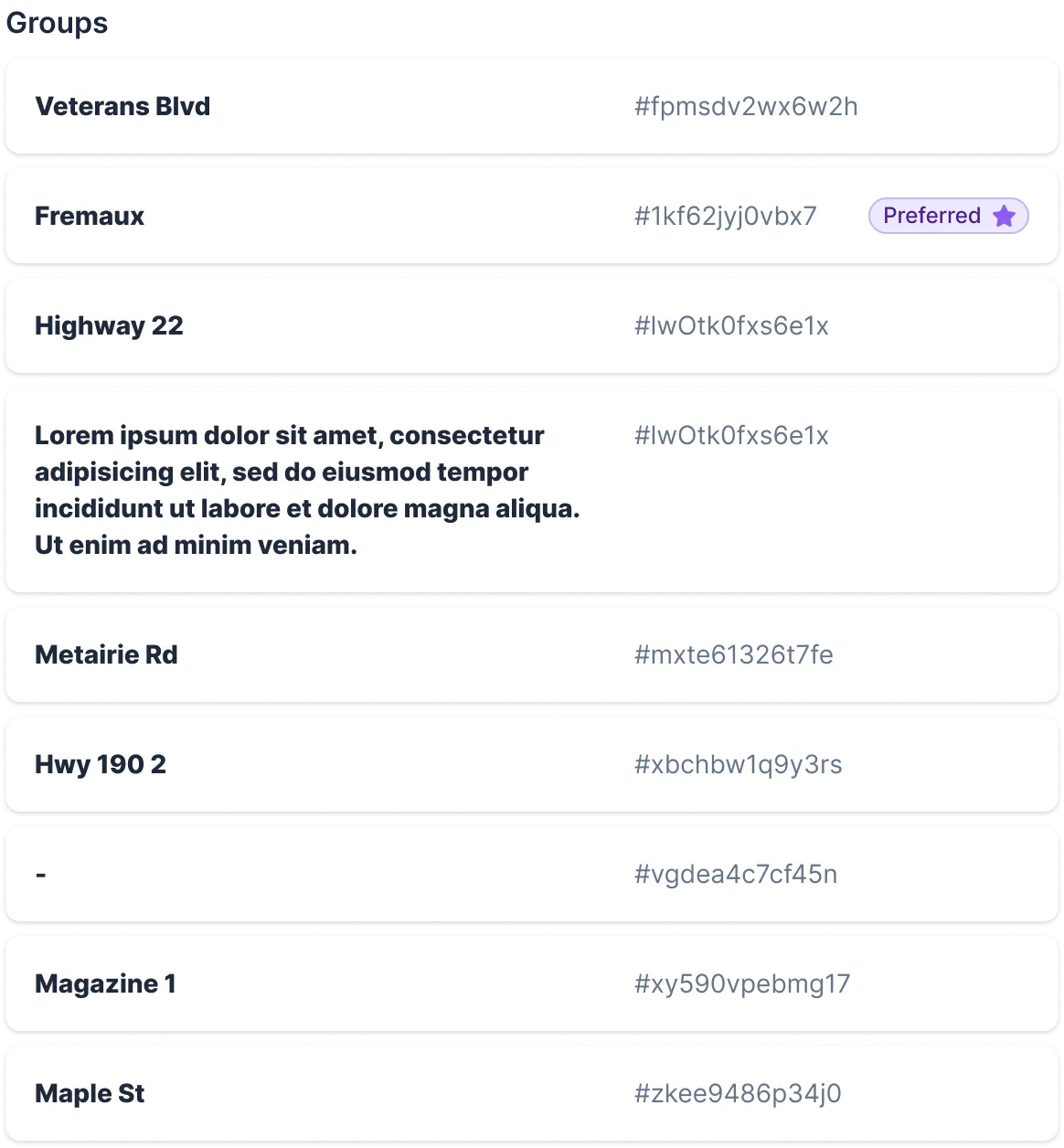Groups: Franchise Hub Lifecycle Management toolset
What is “Groups: Franchise Hub Lifecycle Management toolset”
Groups (in the context of Voxie’s Franchise Hub) are organizational units that represent individual franchise locations, departments, or phone lines in a multi-location business. Voxie Help Center
The Lifecycle Management toolset is the set of features and controls that allow corporate (brand) users to create, configure, manage, and retire these Groups from a central interface. This includes defining how each Group behaves (phone setup, messaging permissions, custom attributes), pushing strategies downstream, and controlling what autonomy each Group has. Voxie Help Center
Key elements include:
-
Defining whether a Group sends messages via its own phone number or via a corporate number
-
Assigning custom attributes to Groups (used in segmentation and dynamic messaging)
-
Setting which Groups receive certain strategies or campaigns (inclusion / exclusion logic)
-
Granting or restricting permissions to Groups to initiate their own messaging
-
Managing Groups' lifecycle: creation, editing, deletion, and phone strategy settings Voxie Help Center
Why It’s Useful / Value Proposition
-
Centralized control with localized flexibility
You can manage overarching messaging strategy at the corporate level while still allowing individual locations (Groups) to carry out localized messaging when appropriate. -
Consistent brand execution
Because corporate defines the core strategies, audiences, and messaging logic, you ensure brand consistency across all locations while still enabling local relevance. -
Efficient scaling and governance
Instead of manually handling each location, the Groups lifecycle toolset lets you roll out configurations, strategies, and permissions to many Groups at once, applying inclusion/exclusion logic. -
Better segmentation & targeting
Group custom attributes enable you to filter or target specific subsets of locations (e.g. “Region = West”, “Flag = Premium Store”) in campaigns or automations. -
Clean lifecycle handling
You can retire, reassign, or delete old Groups cleanly (releasing phone numbers, adjusting contact affiliations) without needing to rework your architecture completely. -
Tailored autonomy
You can determine which Groups have autonomy to initiate certain messaging, and which are restricted to only receive or relay corporate messaging strategies.
Voxie’s Franchise Hub is presented through the set up of Groups, being the answer for those multi-location, multi-department organizations, it allows you to manage your Locations from a centralized control panel, determine strategies for your locations pushing them downstream with defined Audiences and Messages, as well as providing liberties to your locations to issue their own messaging strategies
Before we start, we recommend you to get familiarized with the terminology used fir groups.
Terminology
Concept overview & basic quotasThe overall idea behind the Groups Feature is to enable multi-location businesses to manage their Messaging strategy as flexible as they wish. In this section, we will explain all the variations supported by Voxie to fulfill those strategies for your own business layout.

Layout Understanding
Based on the Market Standards, most layouts consist on a Hub and Spoke model, where the Hub is usually identified as Corporate (Voxie Name), HQ or Marketing Department, whereas the Spokes are Locations, business divisions or departments which in Voxie we call them Groups.
Corporate Manages Strategies
Voxie Strategies Automation remain mostly at Corporate level, including Groups as potential recipients of this strategies.
Corporate can choose the desired strategy leveraging the common Voxie Flow Artifacts (Segments, Campaigns and Automations) adding new logic around the Groups that own the Contacts
Voxie provides a set of capabilities that allows Corporate to decide if the Messaging Strategy is going to be triggered from a centralized Brand action, or can create the Messages (Snippet Templates) and define Audiences, so each Group can decide to send those messages when they believe is best.
Furthermore on this subject, as Corporate you can define which Groups are going to be included or excluded of these actions, as well as, if only Groups Preferred Contacts should be part of the Message Strategy or all affiliates are eligible to do so.
Group Quotas
There are certain default limits around this feature, Voxie will be happy to understand your use cases and evaluate exceptions if needed:
Possible ConfigurationsVoxie allows you to set up your Account Phone strategy in following to variations:
- Each Group (Location) has it’s Phone Number, and therefore Message Hub will be Available in each location. Furthermore, Corporate can send centralized Mass Messaging throughout each individual phone number. In this scenario, is where “Preferred” Contacts are relevant, so Contacts don’t receive the same message issued by Corporate from different Sources
- Single Corporate Phone Number, usually a Shortcode to support throughput correctly, all locations can send their own Quick Blast throughout this Corporate phone Number. In this case Message Hub won’t be available for each location.
Send Messages throughout Individual Locations phones

- Each Group has a phone number, Corporate may as well
- Corporate Issues a Campaign, and decides that Messages will be sent through Individual Group’s Phone Numbers
Send Messages throughout Corporate phones

- Corporate has a single Phone Number
- The Campaign is meant to be a Brand level communication
- Corporate Issues a Campaign from to be sent from Corporate Phone Number
Voxie will help you to set up your Account to leverage the full power of Groups, as a summary the following will need to happen:
- Create Account and Enable Groups
- Define the Phone Number Strategy and issue the needed phone numbers
- Single Shortcode
- A Single Phone Number per Group
- Port your Existing Phone numbers
- Get new ones and register them
- Depending on the Amount of Groups or locations your need, it can be done Manually or Programmatically, we recommend in case there are more than 20 Groups to create a .CSV file with the following information:
External IDGroup NameDescription(Optional)Custom Attributes(One Column per Custom Attribute Key)
- Assign Phone Numbers to your groups if Needed
- Invite Location Users to Voxie
- Once Accepted the Invite, add the Users to the according Groups with the Proper Roles
- You can also create a .CSV file with your users per Group:
- Group
External ID User emailUser First NameUser Last NameUser RoleRefer to theAdministratorMarketerBlastAgent
- Group
Groups is a Feature you need your Voxie Customer Success Manager to enable, please contact support@voxiechat.com to ask for it or directly to your CSM, once enabled, you’ll be able to manage your groups from your Corporate Account

Create a Group
If you need to start creating Groups for your locations, only Owners and Administrator roles can manage lifecycle. You can go to your Settings > Team Settings > Groups, click on New Group

External ID [Required]
In order to create a Group you’ll need to provide an ID, we call it External ID, and we do it so, to replicate your Location or Department designation (ID), so you can have an Integrated match between your centralized management and Voxie.
In addition you’ll be able to use API Destinations to update your systems using this reference
Name[Required]
The name will be the main way to identify Groups across the platform, therefore, we recommend you to make them as meaningful as possible for your operation.
Description [Optional]
Open Text Field, useful to add Metadata around each group, it can be filled with data for disambiguation between similar Groups or described strategies for the given Group.
Custom Attributes [Optional]
Groups Custom Attributes are a Key feature that will enable you to personalize Messages leveraging this Group unique values, you can also use them in Automations.
View, Update or Edit a Group
As a Corporate User you’ll be able to fully EDIT a Group Details with the only exception of the External ID that cannot be modified.
Bare in mind, Phone Numbers will appear only if you assigned them from Voxie Corporate section.
In case you are a Group Administrator you’ll only be able to modify Group’s Custom Attributes, any other needed modification please refer to Corporate Level Administrators
Delete a Group
If a group is deleted, then the contacts that have affiliation with the given Group will remain, unless is explicitly removed by a Corporate user in the Contact Edit section.
- Group assigned Phone Number will be released, and available in Corporate for future assignment
- Contacts will remain attached till corporate re-assign them
- Users will lose membership to the group and no-one will access it anymore
- After deletion, it goes back to the setup required state, so the
External IDwill be taken, if needed, the group can be enabled again.

Corporate Users perspective
As a Corporate User (Owner or Administrator Roles), you’ll be able to navigate throughout Groups as well as configure them.
Voxie presents a Group Picker in the upper right corner, in which you can:
- ALWAYS Understand where you are operating
- If you are in Corporate, overseeing all Group Instances, you’ll notice the selection will be 👑 Corporate.
- If you are within a Group the upper right pill will be showing the Group Name you are in.
- Navigate across Groups, you can search by
Group NameorGroup External ID

- Also if needed, you can Manage your created Groups from Corporate space, going to ⚙️ > Settings > Team Settings > Groups, and click on Edit to:
- Edit Group Details
- Edit Users and Roles
- Understand to which Group Collections the Group Belongs to
- Manage Group Resources
- Contacts
- Segments
- Campaigns
- Snippets

💡 The rest of the Roles at Corporate Level won’t notice the or be able to manage groups, only Corporate Owner and Administrators can
Group Users perspective
Group User interaction with Voxie will depend on the assigned Role, Voxie presents 4 Group Level Roles with the following Scopes:
💡 All complex Voxie Automations, Ad-Hoc Campaigns, All Contact List Segmentations, as well as Account Billing details or Integrations won’t be visible neither accessible by Group Members, unless they belong to Corporate
Contacts in Groups
Contacts will count with ⭐ Preferred Group Attribute that determines which Group is the “Owner” of the given Contact, this is very useful when your business needs to make a distinction between Customers and Leads, where Leads can belong to multiple Locations but Customer if they are under a Subscription will always belong to a single Group.
Some of the Behaviors you need to expect around Preferred Contacts and Affiliated
- A Contact can have only one Group as Preferred
- There can be up to 20 Affiliated Groups
- When Created a Segment or a Campaign, you can specify to Contact only Preferred Contacts or all of them
- When a Group is deleted, Preferred Group remains till Corporate Updates the relationship towards a New Group
- Contacts can be Orphan and have no Preferred Group, in that case Groups can Claim them through 1:1 communications.
- Groups cannot have 1:1 conversations with not Preferred Contacts

Group Details on A Contact View Screen, from Corporate
Contacts AffiliationA very relevant concept that Groups introduces, is the Contact affiliation with Groups, the idea is to differentiate between those Groups that have a long term relationship with Contacts, because the line of business is based on a Subscription or similar, versus, Contacts that have a brand level interactions with individual Groups based on the locations.
For those Groups with Long term relationship with contacts, and they keep the interactions in a one to one fashion, we introduced the [Preferred] Group attribute, each Contact can have a preferred Group from which it can receive Messages.
Once set, only Corporate can change the preference of Group - Contact relationship.
Additional Related Resources: